Brain tan
2014-05-15
I just completed my first full solo braintan hide. Our friend Red taught us how to soften hides some years ago, but doing the entire process yourself is different. Jess has done several, but this is my first.
The goal is to go from a green deer-hide (exactly what you'd have after skinning a deer), to a piece of fabric ready to make clothing, bags, or other equipment out of. Like this:
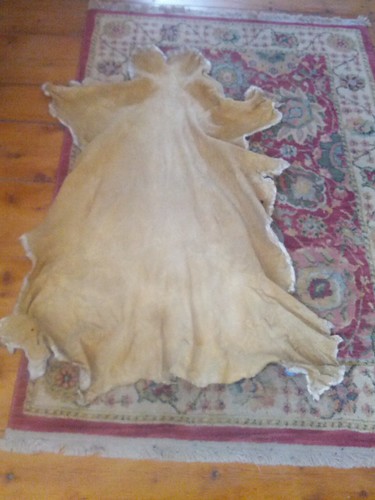
The materials I used are:
- A bar of steel (as a scraper)
- gloves (for the bar of steel)
- rope
- elmers glue
- clothes-pins
- axe
- shovel
- a few downed trees
- a small plywood board
- bucket
- vegetable oil
- dawn and dr.brauners soap
I got the deer-hide from a friend in Washington. She skins deer every year for a game processor. Basically, people hunt deer and don't want to process it themselves, they drop it off at a game processor and the processor gives them meat back a couple days later. Jess and my friend skins the deer for the game-processor in exchange for the deer-hides.
I took that hide, which was "wet salted", meaning it had been salted before the hide was dry. After washing off a bit of the salt I put it in a stream for a while to rehydrate.
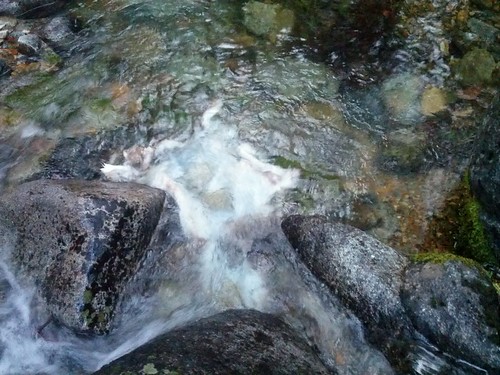
Then, I put it in a bucket and basically let it rot for several days, changing the water every day or two. Eventually when I reached in and pull the hair, the hair slid out easilly. At this point I put it on a scraping beam (a log) and scraped the hide until all the hair was off. Here's the beam I used.

The other hide I was working on (not yet complete) was being a bare, so I decided to "buck" this hide. That's where you soak it in a lie solution. I dug ash out of an old fire-pit in an area with softwoods. I mixed in water then let it sit until the junk had settled out, and scooped out the junk. After a couple passes I had a weak lie solution. It's weak because the ash was old and was from softwoods. I then soaked the hide in this solution overnight.
I pulled the hide out and rinsed it a couple of times to get the lie out. Then I scraped it again, this time on the other side, to take the grain off (or most of the way off). The following picture is of a different hide, but this is the idea:

The following picture shows the difference, the part on top is unscraped, the part on the side of the log has been scraped and the grain removed.
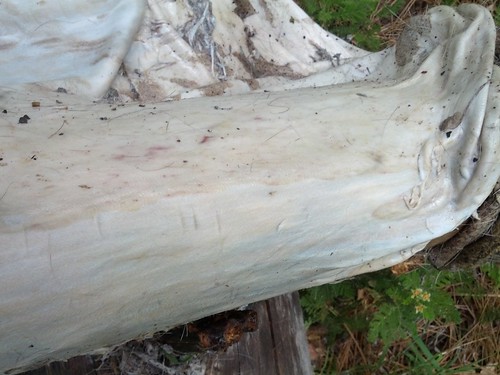
Then I mixed up a braintan solution. This can be any oil with a surfactant so it goes into solution. I used canola oil and initially Dr. Brauners. The solution was just too oily though (because Dr. Brauner's isn't a surfactent), so I added some dawn.
Then I worked the hide stretching and opening it up. There are other ways to do this, but I did it on a horizantal beam, lashed to two trees.
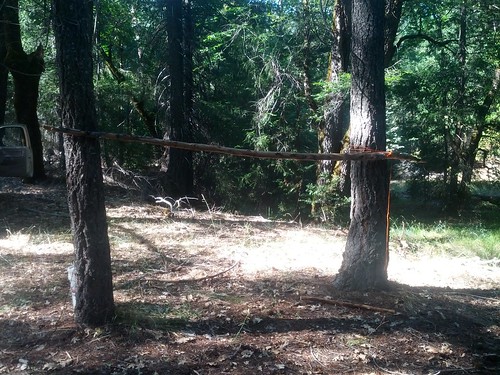
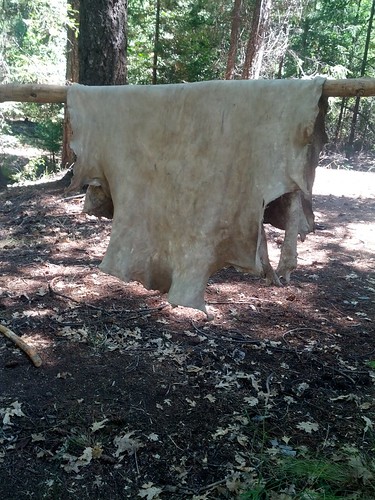
Now it felt soapy though, when I squeezed it or stretched it soap foam came out of the hide. So I rubbed oil into the surface, just a bit, until the two were balanced again. This worked extremely well. This was a thin doe-hide. I believe it was mule-deer, but it just happened to be an easy tan. It came out really soft even then. I couldn't smoke in California easily due to the fire-ban I figured putting off tons of smoke was just pushing it too far, so I waited.
In Vermont we finally had a place to smoke. I made a call to the fire warden to check that it was okay. I dug a pit about 2.5' deep, and then another pit next to it. I dug a hole between the pits to connect them.
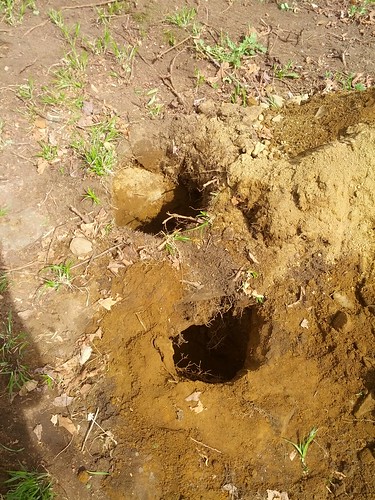
I took a 3'x3' square of canvas and stitched it into a tube. I took my hide and glued it once side to the to the other, also into a tube, but with one end closed. To the open end of the tube I glued the canvas. This was done with elmer's white-glue (which is basically hide-glue, so it bonds really well). The clothes-pins in the photo are to hold it in place, given a full package of clothes-pins you can just continuously glue, it will set up fast enough that you can just pull the oldest clothes-pin and place it on where you are gluing now and keep going.
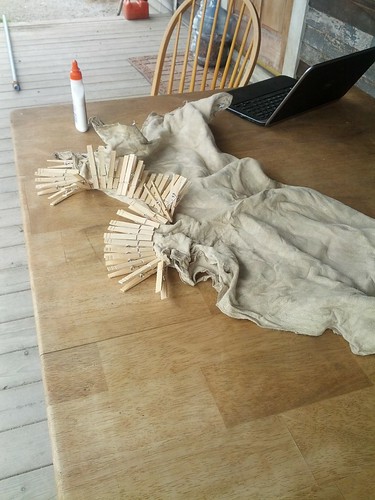
I lit a fire in the pit to dry it out and get some coals going while I worked. I took some downed trees and made a tripod. I left stubs of branches so they'd sit together securely and I could be lazy about lashing. A little more rope-work and I had my hide hung up. It's held open inside by sticks jammed in one way and then the other, so it stands up an as a tube. I made a pile of the punk I'd gathered the day before (this is just a bit of it).
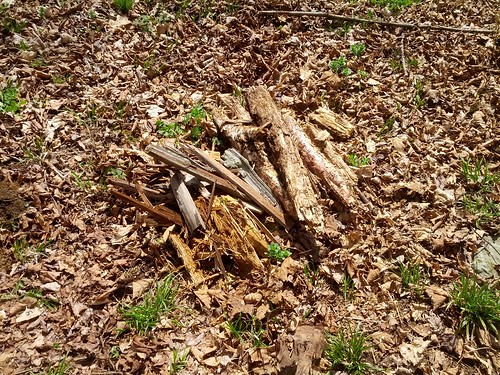
I dumped the punk in on the coals and put a board over the main hole so the smoke would have to come out the side-hole where the hide was hanging. This worked well because the heat still goes upwards, thus it's hard to accidentally char your hide, even if the fire burns instead of smoldering.
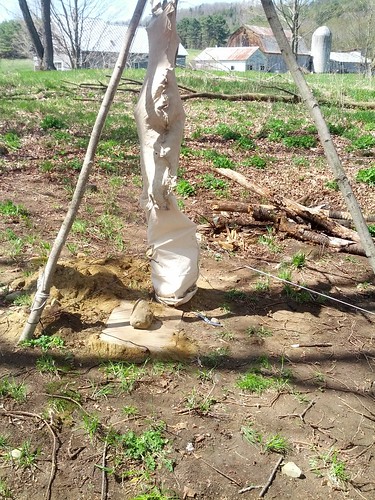
The whole thing kept swinging in the breeze, so eventually I tied the skirt out to all 3 sides of the tripod. This was my first smoke, so it took a while. 6 or so hours later I was getting frustrated. The smoke was all getting carried away in the breeze. The canvas was pretty permiable so most smoke blew out of the skirt before it even made it to the hide.

I'd been waiting for the color to come *through* the hide. When Jess got back from her trip I showed it to her, and she said you only need to go until color shows on all of one side of the hide, then flip it and do the other.
So, I flipped it, smoked it again and washed it. This time I shortened the skirt to only 1.5 feet (cut the one I had in half). I also cuffed the bottom a lot to act as a baffle. I'd been paranoid about the heat originally, but it turned out that because of the side-hole it was never even nearly hot enough to cause problems, I probably could've used no-skirt from a heat perspective. This went *much* faster, and I had a minimal smoke in maybe 1.5 hours.
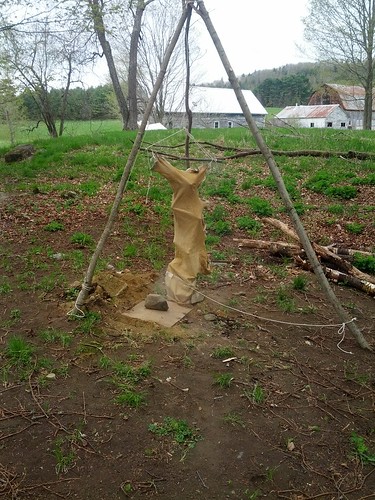
Again I tore it apart. Then I threw it straight into the washing machine. When it came out, it was just a touch stiff. This is just how buckskin works. After a quick pull in each direction it felt pliable and soft again. I can't wait to make some clothing out of this.
Possibly surprising notes for tanners:
When I completed smoking the second day the hide was downright *wet*. It was so humid and the punk wasn't dry I was pushing water through the hide. This seems not to have had a negative effect. Even the first day the smoke coming off the fire was very humid.
Also interesting, this hide was stored in the truck for many months after being softened, but before being smoked. In the time it rained many many times. The truck spent a couple months well below freezing, then crossed back and forth many times causing extreme humidity. For whatever reason this appears not to have been a problem. The hide was never *wet*, it was in a duffle bag near the cab, so well protected, but the humidity has to have gotten to it.

